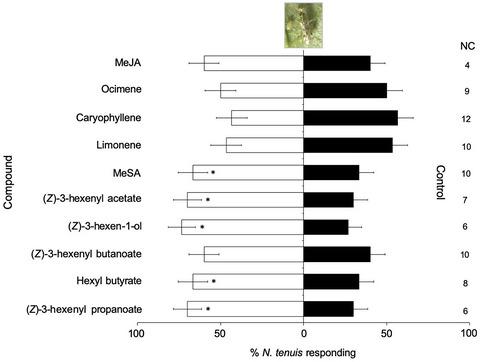当前位置:
X-MOL 学术
›
Entomol. Exp. Appl.
›
论文详情
Our official English website, www.x-mol.net, welcomes your
feedback! (Note: you will need to create a separate account there.)
Response of mirid predators to synthetic herbivore‐induced plant volatiles
Entomologia Experimentalis et Applicata ( IF 1.4 ) Pub Date : 2020-09-27 , DOI: 10.1111/eea.12970 Diego B. Silva 1, 2 , Alberto Urbaneja 2 , Meritxell Pérez‐Hedo 2
Entomologia Experimentalis et Applicata ( IF 1.4 ) Pub Date : 2020-09-27 , DOI: 10.1111/eea.12970 Diego B. Silva 1, 2 , Alberto Urbaneja 2 , Meritxell Pérez‐Hedo 2
Affiliation

|
Zoophytophagous plant bugs feed on plant tissue as a source of water and nutrients, besides feeding on prey. By phytophagy, mirid predators activate plant defense responses through different pathways, resulting, among others, in the release of herbivore‐induced plant volatiles (HIPVs). These compounds could repel herbivores and attract parasitoids and predators, and synthetic versions could potentially be used in biological control. Nevertheless, little is known about the influence of synthetic volatiles on mirid attraction. Using Y‐tube olfactometer trials, we evaluated the responses of Nesidiocoris tenuis (Reuter), Macrolophus pygmaeus (Rambur), and Dicyphus bolivari Lindberg (Hemiptera: Miridae), important natural enemies used to control various greenhouse pests, to 10 synthetic versions of HIPVs released from tomato (Solanum lycopersicum L., Solanaceae) plants induced by N. tenuis and M. pygmaeus. Nesidiocoris tenuis responded to five of the 10 HIPVs, whereas M. pygmaeus and D. bolivari responded to four of the 10 HIPVs. Two green leaf volatiles, (Z)‐3‐hexenyl propanoate and (Z)‐3‐hexenyl acetate, and the ester methyl salicylate (MeSA) were attractive to all three mirid predator species. Our results demonstrate that the volatiles released by tomato plants activated by N. tenuis and M. pygmaeus phytophagy are attractive to their conspecifics and also to D. bolivari. Further studies should evaluate the potential of these compounds to attract predatory mirids in the field.
中文翻译:

昆虫捕食者对合成草食动物诱导的植物挥发物的反应
除了以猎物为食外,食虫性植物臭虫还以植物组织为食,作为水和营养的来源。通过植物吞噬,mirid 捕食者通过不同的途径激活植物防御反应,导致草食动物诱导的植物挥发物 (HIPV) 的释放。这些化合物可以击退食草动物并吸引寄生物和捕食者,合成版本有可能用于生物控制。然而,关于合成挥发物对微光吸引力的影响知之甚少。使用 Y 型管嗅觉计试验,我们评估了 Nesidiocoris tenuis (Reuter)、Macrolophus pygmaeus (Rambur) 和 Dicyphus bolivari Lindberg (Hemiptera: Miridae)(用于控制各种温室害虫的重要天敌)对 10 种合成版本的 HIPV 的反应从番茄 (Solanum lycopersicum L., Solanaceae) 植物,由 N. tenuis 和 M. pygmaeus 诱导。Nesidiocoris tenuis 对 10 个 HIPV 中的 5 个有反应,而 M. pygmaeus 和 D. bolivari 对 10 个 HIPV 中的四个有反应。两种绿叶挥发物,(Z)-3-己烯基丙酸酯和 (Z)-3-己烯基乙酸酯,以及水杨酸甲酯 (MeSA) 对所有三种捕食者都很有吸引力。我们的结果表明,由 N. tenuis 和 M. pygmaeus phytophagy 激活的番茄植物释放的挥发物对其同种植物和 D. bolivari 都具有吸引力。进一步的研究应该评估这些化合物在野外吸引掠食性蝾螈的潜力。(Z)-3-己烯基丙酸酯和(Z)-3-己烯基乙酸酯,以及水杨酸甲酯酯(MeSA)对所有三种捕食者都很有吸引力。我们的结果表明,由 N. tenuis 和 M. pygmaeus phytophagy 激活的番茄植物释放的挥发物对其同种植物和 D. bolivari 都具有吸引力。进一步的研究应该评估这些化合物在野外吸引掠食性蝾螈的潜力。(Z)-3-己烯基丙酸酯和(Z)-3-己烯基乙酸酯,以及水杨酸甲酯酯(MeSA)对所有三种捕食者都很有吸引力。我们的结果表明,由 N. tenuis 和 M. pygmaeus phytophagy 激活的番茄植物释放的挥发物对其同种植物和 D. bolivari 都具有吸引力。进一步的研究应该评估这些化合物在野外吸引掠食性蝾螈的潜力。
更新日期:2020-09-27
中文翻译:

昆虫捕食者对合成草食动物诱导的植物挥发物的反应
除了以猎物为食外,食虫性植物臭虫还以植物组织为食,作为水和营养的来源。通过植物吞噬,mirid 捕食者通过不同的途径激活植物防御反应,导致草食动物诱导的植物挥发物 (HIPV) 的释放。这些化合物可以击退食草动物并吸引寄生物和捕食者,合成版本有可能用于生物控制。然而,关于合成挥发物对微光吸引力的影响知之甚少。使用 Y 型管嗅觉计试验,我们评估了 Nesidiocoris tenuis (Reuter)、Macrolophus pygmaeus (Rambur) 和 Dicyphus bolivari Lindberg (Hemiptera: Miridae)(用于控制各种温室害虫的重要天敌)对 10 种合成版本的 HIPV 的反应从番茄 (Solanum lycopersicum L., Solanaceae) 植物,由 N. tenuis 和 M. pygmaeus 诱导。Nesidiocoris tenuis 对 10 个 HIPV 中的 5 个有反应,而 M. pygmaeus 和 D. bolivari 对 10 个 HIPV 中的四个有反应。两种绿叶挥发物,(Z)-3-己烯基丙酸酯和 (Z)-3-己烯基乙酸酯,以及水杨酸甲酯 (MeSA) 对所有三种捕食者都很有吸引力。我们的结果表明,由 N. tenuis 和 M. pygmaeus phytophagy 激活的番茄植物释放的挥发物对其同种植物和 D. bolivari 都具有吸引力。进一步的研究应该评估这些化合物在野外吸引掠食性蝾螈的潜力。(Z)-3-己烯基丙酸酯和(Z)-3-己烯基乙酸酯,以及水杨酸甲酯酯(MeSA)对所有三种捕食者都很有吸引力。我们的结果表明,由 N. tenuis 和 M. pygmaeus phytophagy 激活的番茄植物释放的挥发物对其同种植物和 D. bolivari 都具有吸引力。进一步的研究应该评估这些化合物在野外吸引掠食性蝾螈的潜力。(Z)-3-己烯基丙酸酯和(Z)-3-己烯基乙酸酯,以及水杨酸甲酯酯(MeSA)对所有三种捕食者都很有吸引力。我们的结果表明,由 N. tenuis 和 M. pygmaeus phytophagy 激活的番茄植物释放的挥发物对其同种植物和 D. bolivari 都具有吸引力。进一步的研究应该评估这些化合物在野外吸引掠食性蝾螈的潜力。











































 京公网安备 11010802027423号
京公网安备 11010802027423号